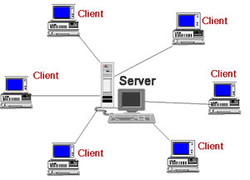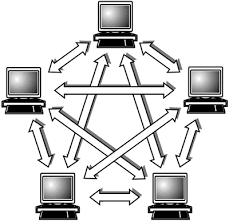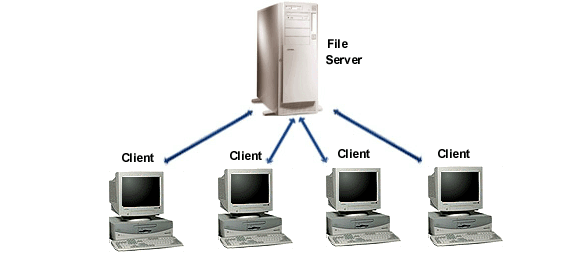Network architectures is the way network are designed to communicate.
Types of network architecture :-
1.Peer-to-peer (P2P)
2.Client-Server


Client-Server Network Peer-to-peer
Definition :
1. A network model in which all computers can function as
clients or servers as needed, and there’s no centralized
control over network resources.
2. Is a simple, inexpensive network that typically connects
fewer than 10 computers.

Peer-to-peer diagram
Definition :
Network in which one or more computers act as a server, and the other computers (clients) on the network request services from the server.


Client-server network Client-server network diagram
Servers are special, powerful computers that provide ‘services’ to the client computers on the network.
These services might include:
~ Providing a central, common file storage area
~ Sharing hardware such as printers
~ Controlling who can or can’t have access the network
~ Sharing Internet connections
An architecture in which the user's PC (the client) is the requesting machine, and the server is the supplying machine, both of which are connected via a local area network (LAN) or a wide area network (WAN) such as the Internet.


Client-Server Network Peer-to-peer
Peer-to-Peer Network
Definition :
1. A network model in which all computers can function as
clients or servers as needed, and there’s no centralized
control over network resources.
2. Is a simple, inexpensive network that typically connects
fewer than 10 computers.

Peer-to-peer diagram
Client-Server Network
Definition :
Network in which one or more computers act as a server, and the other computers (clients) on the network request services from the server.


Client-server network Client-server network diagram
Servers are special, powerful computers that provide ‘services’ to the client computers on the network.
These services might include:
~ Providing a central, common file storage area
~ Sharing hardware such as printers
~ Controlling who can or can’t have access the network
~ Sharing Internet connections
An architecture in which the user's PC (the client) is the requesting machine, and the server is the supplying machine, both of which are connected via a local area network (LAN) or a wide area network (WAN) such as the Internet.
| Types of network | Advantages | Disadvantages |
| Peer-to-Peer | 1. Less startup cost to setup the network architecture - No need for a server. 2. Easy to Setup up - An operating system (such as Windows XP) already in place may only need to be reconfigured for peer-to-peer operations. |
1. Decentralized - No central repository for files and applications. 2. Less Security - Does not provide the security available on a client/server network |
| Client-Server | 1. Centralized - Resources and data security are controlled through the server. 2. Scalability - Any or all elements can be replaced individually as needs increase. 3. Flexibility - New technology can be easily integrated into system. |
1. Expense - Requires initial investment in dedicated server. 2. Maintenance - Large networks will require a staff to ensure efficient operation. 3. Dependence - When server goes down, operations will cease across the network |